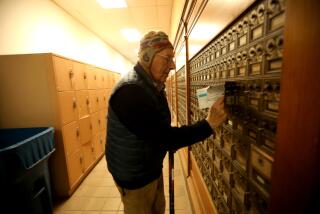Artesia Split on Little India Proposal
- Share via
Artesia is a bedroom community of 16,000 people that is easy to miss while driving along the freeway. But exit onto Pioneer Boulevard and you enter Little India, a series of strip malls filled with spice stores, jewelers specializing in South Asian designs, shops that make intricate henna tattoos and many restaurants.
To some, Little India made Artesia a trendy shopping destination. With that in mind, a state assemblyman representing the area has proposed placing “Little India” exit signs on the Artesia Freeway.
But the proposal has fueled debate among city residents, with many saying that they don’t want multiethnic Artesia to bear one group’s label. The City Council voted to oppose the sign, and residents collected more than 1,000 signatures on a petition opposing the idea.
“It’s divided our city,” said Councilman Larry Nelson. “It’s not fair to pick out one group. We’re a city of many cultures.”
Within the last two decades, the former dairy town, settled by Dutch and Portuguese immigrants in the late 1800s, has become known as the home of Little India for its concentration of Indian-owned businesses that began opening on Pioneer Boulevard in the 1980s, revitalizing the once deteriorating main street.
But most residents and businesses in the 1.62-square-mile city are not Indian American.
No ethnic group is in the majority in the city. Latinos make up the largest group at 38%, with whites and Asians at 27% each. Indian Americans are less than 5%. Indian Americans run about 20% of Artesia’s 385 retail businesses.
Assemblyman Rudy Bermudez (D-Norwalk) decided to propose the “Little India” signs because the business district has become such a draw.
“This is what puts Artesia on the map,” said Keith Malone, Bermudez’s district director.
Sumita Batra, an Indian American and owner of Ziba Beauty Center, agreed: “Much like Disneyland is a destination in Anaheim, we are a destination in the city of Artesia.”
But, a few blocks away, Nilo and Celia Pinawin, owners of Superstar Video, a Filipino-language video and music store, disagreed.
“A lot of Filipinos and Asians are here, not only Indians,” Nilo Pinawin said.
Pinawin worries that the sign will confuse potential customers into thinking that the city is exclusively Indian, making people look elsewhere for the specialized videos he and his wife sell.
“What will happen to our business?” Celia Pinawin said.
Bermudez in March proposed installing “Little India” signs on the freeway, along with markers noting a nearby Portuguese meeting hall.
Bermudez said he did so at the behest of some Indian and Portuguese community members. But officials at the Portuguese hall said they do not want signs for the hall.
Paulo Menezes, a longtime resident who circulated petitions opposing the signs, said: “I’m Portuguese, and we’re not better than the rest of the community. As a multicultural city, we have to have respect for our neighbors.”
A city public hearing was attended by several hundred Artesia residents and business owners, many of whom spoke against the proposal.
Although city officials have no power to stop the signs -- the state controls the freeways -- the council passed a resolution against the sign and hired a lobbyist for $5,000 a month to fight the bill.
Citing the budget crisis, Bermudez pulled the bill temporarily. But hearings are now scheduled for late June.
Meanwhile, the debate has drawn Indian merchants closer.
Batra said they recently formed the Little India Business Council to promote Little India and do community outreach.
Batra said that as they work toward the exit signs, they will purchase a billboard along the Artesia Freeway to advertise Little India.
Batra said she wants Artesia to know that the sign is not meant to be divisive.
“Just because I say we exist, it doesn’t mean that you don’t,” Batra said.
More to Read
Sign up for Essential California
The most important California stories and recommendations in your inbox every morning.
You may occasionally receive promotional content from the Los Angeles Times.













